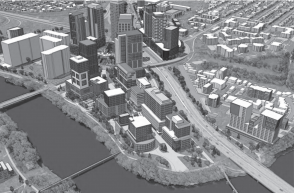By John Dance
The old adage “you can’t fight City Hall,” took a beating when Ottawa City Council recently reversed its December 2020 decision to transfer the University of Ottawa (UOttawa) Lees Avenue campus from Capital Ward to RideauVanier Ward, following an appeal filed by the Old Ottawa East Community Association (OOECA).
In its appeal of the original decision to the Local Planning Appeals Tribunal, OOECA noted, “City Council’s decision to approve this ward boundary transfer is unwarranted and unreasonable, although perhaps not surprising, since it resulted from the City staff’s two-fold failure to accurately describe the recommended transfer and properly assess the suggested transfer against the established effective representation criteria.”
Ward boundary changes are periodically required to reflect varying rates of population change within wards so that there is effective representation, based upon reasonable voter parity of all wards, while also ensuring that physical boundaries and “communities of interest” are respected.
In their recommendation to reverse Council’s initial decision, City staff dismissively termed the OOECA request a “modest modification,” however, staff offered no defence of why the initial decision had been recommended.
City staff also recommended reversing another ward boundary change decision, this one affecting Overbrook, also a case where the local community association had appealed the matter, citing poor consultation.
“It is not often that you can beat City Hall, but clearly these two community associations have shown that you can,” noted Alex Cullen, President of the Federation of Citizens’ Associations. “The arbitrary decisions (…) without consultation with the affected communities provoked these appeals. It is a lesson to the politicians that due process and community consultation counts.”
In support of City staff’s recommendation to overturn the original decision, City Clerk Rick O’Connor informed councillors that the City’s legal services engaged in discussions regarding the appeals with each appellant/ appellant’s counsel…”
However, these “discussions” with OOECA consisted of one email from city lawyer Tim Marc, simply saying, “City staff are prepared to seek instructions from Council to seek modifications to the above by-law by the Local Planning Appeal Tribunal to reinstate the boundary(…). I trust that the Old Ottawa East Community Association will find this satisfactory.”
Back in December, in proposing the original decision, staff’s “Recommendations Report” spoke of transferring just the University of Ottawa’s sports field from Capital Ward to Rideau-Vanier Ward.
Councillors were misled by this wording because, as an accompanying map showed, the recommended boundary change was more substantial and encompassed the entire Lees Avenue campus. Similarly, the report stated that “#417 is not a big boundary; use the River instead.”
This assertion was also false because the Rideau River would not have become the new boundary.
Instead it would have been the below-grade LRT line, a feature much less pronounced than Highway 417, which is the longstanding and conspicuous boundary between OOE and Rideau-Vanier’s Sandy Hill.
At the time, staff also recommended the transfer of the UOttawa sports field because it “is directly associated with sports facilities to the north in the current Rideau-Vanier Ward.”
The reality, as shown by information provided by Capital Ward Councillor Shawn Menard, is that there were just four organizations which rented the City sports field north of 417 and it’s not clear if any of them also made use of the uOttawa field.
Staff omitted reference to the century-long relationship of the Lees Avenue campus area to Ottawa East despite the fact that primary “communities of interest” are among the key factors in determining ward boundaries.
Arguably, the most egregious aspect of staff’s original recommendation was the argument that the transfer would have no impact on voter parity because, as Beate Bowron, the City’s consultant responsible for the boundary change, noted, “[T]here will be no residents in the affected area during the project timeframe.”
The reality, however, is that the area recommended for transfer is zoned to have 20-, 30- and 45-storey buildings.
Councillor Menard, who had voted against the new ward boundaries in December, congratulated OOECA for the successful outcome of its LPAT appeal. For his part, Rideau-Vanier Councillor Mathieu Fleury told The Mainstreeter, “I voted against the Ward Boundary report back in December as I don’t believe the consultants were able to properly capture community needs and feedback in their analysis and recommendations.”

City of Ottawa image
The campus is zoned for massive redevelopment, as shown, a fact ignored when City Council first approved the transfer to the more populous Rideau-Vanier Ward.
The Mainstreeter will continue to pursue the questions of who initiated the suggestion to transfer the Lees Avenue campus, why it was recommended despite its failing to meet necessary criteria and what will be the consequences of staff’s failure to properly analyse and consult on proposed ward boundary changes.
Bob Gordon, OOECA president, expressed his gratitude to several local residents, including retired lawyer Jeff Brown, who volunteered their expertise to ensure the LPAT appeal was sound.
Although the City has now agreed to reinstate the Lees Avenue campus to Capital Ward, the LPAT has yet to consider OOECA’s appeal and the City’s reversal of its initial decision.






